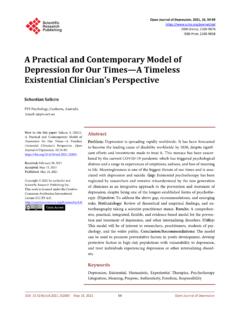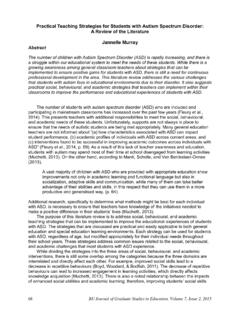Transcription of A Practical Guide to Developing Career Pathways - Michigan
1 May 29, 2018. A Practical Guide to Developing Career Pathways A Practical Guide to Developing Career Pathways Table of Contents Introduction ..3. Definition and Value Proposition ..4. Definition .. 4. Value 4. Career Pathways : Founded in Business-Led Industry Sector Partnerships ..6. 1. Convener initiates the 7. 2. Convener pulls public partners together to form the initial partnership.. 7. 3. Collect, aggregate, and review data.. 8. 4. Engage targeted 8. 5. Reconvene partners to share initial industry input.. 8. 6. Ongoing, deepening partnership conversations continue.. 9. Career Pathways Development Process Map ..10. The Career Pathways Development Process in Depth.
2 11. 1. Conduct exploratory research about the occupations in the industry..11. Key 11. Tools and Resources .. 11. 2. In ongoing conversations, discuss key occupations and Pathways with industry partners and with other sector partnership partners..12. Key 12. Tools and Resources .. 13. 3. Develop Career pathway maps and refine with industry partners..13. Key 13. Tools and Resources .. 14. 4. Conduct an education and training gap and oversupply analysis..16. Key 16. Tools and Resources .. 16. 1. A Practical Guide to Developing Career Pathways 5. Begin the education and training development and modification process with public partners..17. Key 17. 6.
3 Identify and address related resource, policy, and other needs and barriers..19. Key 19. Tools and Resources .. 19. 7. Finalize education and training programming design and develop an implementation and assessment plan..20. Key 20. Tools and Resources .. 20. 8. Implement education and training programming, evaluate outcomes, and adjust approaches as necessary..21. Key 21. Resources ..22. Conclusion ..23. Appendix A: Career Pathways Self-Assessment ..24. Appendix B: Training Gap Analysis Matrix ..29. Appendix C: Resource Mapping Template ..30. Appendix D: Sample Measures ..32. 2. A Practical Guide to Developing Career Pathways Introduction This Career Pathways framework has been developed for local, regional, and state stakeholders in Michigan to assist them in the process of designing and implementing Career Pathways programs and integrated Career Pathways systems for both student/job seeker/worker and business/industry customers.
4 The framework discusses Career Pathways development in the context of, and as a key strategic priority of, industry sector partnerships. It is provided as a tool to assist industry, workforce development, education, and other partners in sector partnerships tackle the concrete steps involved in understanding business-driven Career Pathways and aligning their education, training, and other programming accordingly, with the goal of Developing integrated Pathways systems that provide the most value for business partners and the most opportunity for students, job seekers, and workers. Please note that a Career Pathways readiness self-assessment tool is provided in Appendix A.
5 Readers are encouraged to review the entire framework and the related resources provided throughout before completing the self-assessment. 3. A Practical Guide to Developing Career Pathways Definition and Value Proposition Definition Career Pathways are connected systems of education and training programs that build upon one another to help a person enter and advance in his/her Career in an industry. Pathways are business-defined and business-driven and aligned to the skill needs of targeted industry sectors and are explicitly focused on helping people more easily and quickly enter into and advance in their careers. In many cases, Career Pathways are an example of a priority industry sector strategy pursued by sector partnerships.
6 Key features of Career Pathways include: They connect and articulate the full range of K-12, adult education, post-secondary, and other education and training, with seamless transitions between levels and no dead ends ;. They have multiple on- and off-ramps to make it easy for individuals to start, stop, and re-enter education and training;. They embed stackable industry-recognized credentials;. They make work a central context for learning, through on-the-job training, Registered Apprenticeship, work-based internships and mentorships, and other avenues;. They accelerate educational and Career advancement through assessment of prior learning and experience, integrated basic education and technical training, and other strategies; and They provide integrated supports like coaching and advising and services like childcare and transportation assistance, especially at education and Career transition points.
7 Put simply, Career Pathways identify the Career opportunities in an industry, entry-level to advanced, and show how an individual can grow his/her Career in the industry. Value Proposition The Career Pathways model offers significant benefits for business and student/job seeker/worker customers, as well as for public partners in workforce development, education, and related systems. For businesses, the Pathways approach provides: A process for thinking comprehensively about their expectations for each of their positions and clearly defining both necessary and realistic requirements;. An opportunity to ensure that education and training are aligned to actual industry and company needs.
8 A ready talent pipeline with the right education, skills, and credentials;. A strategy for increasing employee retention;. A model for supporting Career advancement, succession planning, and back-filling; and A process for connecting to new and more diversified talent pools in tight labor markets facing worker shortages. For students, job seekers, and workers, Career Pathways offer: A Career development roadmap that takes the mystery and guesswork out of understanding what careers and Career progression look like in various industries and what the real requirements are for Career advancement;. 4. A Practical Guide to Developing Career Pathways A way for customers, particularly those with multiple barriers to employment and advancement, to see themselves in careers and have access to Career development information and experience they might not otherwise be exposed to.
9 Education and training that is aligned to real-world occupational progressions and workforce needs;. More opportunities to learn on the job;. Accelerated Career advancement opportunities;. New Career entry and advancement opportunities, particularly for individuals with barriers to employment and Career development; and Integrated supports and Career coaching. For public partners in the workforce development, education, human services, and related systems, the Career Pathways model offers: A process for better aligning and integrating services and resources;. Reduced duplication of efforts and investments;. Improved outcomes for a variety of customer groups.
10 Improved access to and engagement of previously-disengaged populations;. Better connections to business and industry partners and alignment with their workforce needs;. Stronger relationships with other public partners; and Increased opportunities for better service utilization and coordinated service planning and delivery. 5. A Practical Guide to Developing Career Pathways Career Pathways : Founded in Business-Led Industry Sector Partnerships Strong and business-driven industry partnerships are the foundation for Career Pathways development, and Career Pathways development is often a key strategy prioritized by businesses in a sector partnership. Through the sector partnership, businesses in a target industry define key Pathways in their industry and typical occupational progressions through those Pathways , along with associated education and training, competency, and credential requirements at each level.













